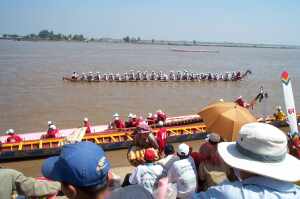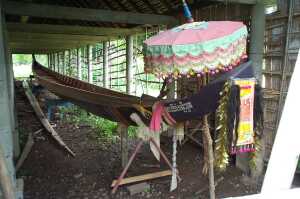 Starting on the day of the full moon in late October or early November, up to a million people from all walks of life and from all over the country flock to the banks of the Tonle Sap and Mekong Rivers in Phnom Penh to watch traditional boats racing on a huge scale. This year more than 400 of the brightly colored boats with over 2,500 paddlers battled it out for top honors. The boat racing dates back to ancient times marking the strength of the powerful Khmer marine forces during the Khmer empire.
Starting on the day of the full moon in late October or early November, up to a million people from all walks of life and from all over the country flock to the banks of the Tonle Sap and Mekong Rivers in Phnom Penh to watch traditional boats racing on a huge scale. This year more than 400 of the brightly colored boats with over 2,500 paddlers battled it out for top honors. The boat racing dates back to ancient times marking the strength of the powerful Khmer marine forces during the Khmer empire.
During the day, the boats race in pairs along a kilometer-long course, and then in the evening brightly decorated floats cruise along the river prior to and during the nightly fireworks displays.
There is often a parallel festival at Angkor Wat and although it is smaller in scale it is just as impressive due to the backdrop of Angkor Wat.
The festival marks the changing of the flow of the Tonle Sap River and is also seen as thanksgiving to the Mekong River for providing the country with fertile land and abundant fish. It is at this time when the river flow reverts to its normal down-stream direction. In a remarkable phenomenon, the Tonle Sap River earlier reverses its course as the rainy season progresses, with the river flowing "upstream" to Tonle Sap Lake. Then as the rainy season tapers off, the river changes direction once again as the swollen Tonle Sap Lake begins to empty back into the Mekong River, leaving behind vast quantities of fish.
 Most of the boats are stored in local Buddhist monasteries (wats) because those are the only places with enough flat land and space to store a very long boat!
Most of the boats are stored in local Buddhist monasteries (wats) because those are the only places with enough flat land and space to store a very long boat!